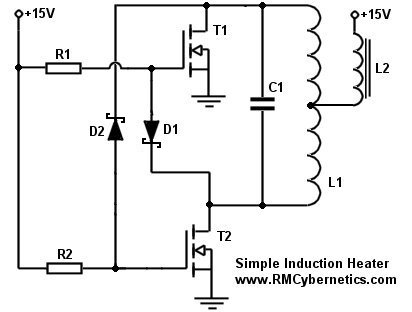So having written that I was unsure as to whether induction stoves could be made to work with Direct Current, it turns out that internally most induction hob appliances (maybe all? – not sure) convert the AC back into DC!

First let me thank Subodh Mathur who commented on the blog and pointed out this thesis.
Second, let me thank Kirk Smith who has done some great work on clean cooking and health, and as a non engineer mentioned to me that he thought Induction hobs worked off DC inside the appliance.
So in between writing the last blog and this one, we have ripped apart an induction hob and watched a lot of youtube DIY induction furnaces, and have been able to experiment and explore driving induction from batteries. (I probably should have done that before admitting my ignorance in the previous blog!).
In my defence, let me say that my confusion was partly fueled by the way people write about Induction heating. The wikipedia entry states :”An induction heater consists of an electromagnet, and an electronic oscillator that passes a high-frequency alternating current (AC) through the electromagnet. It implies that the appliance needs AC. I say implies because when I read it more carefully it is talking about high frequency AC not mains 50Hz AC. What is happening inside the appliance is that the AC is getting converted back to DC, then the DC is used to generate a high-frequency oscillation. More of the order of 50 to 200kHz. (Note that is kilohertz not hertz).
So yes, a variant of the PV-ecook system could include an induction hob rather than a hot plate. By doing so we could potentially make efficiency gains, and that in turn could reduce the overall cost.
Its good that that is an option for the longer term. When we first proposed the system we thought mainly about a hot plate – to ease the behavioral change issues. We reasoned that hot plate was similar enough to hot charcoal for people to make the switch.
Induction hobs although being more efficient have two negatives that need to be considered. The first is they are to many people deep mystery! Of course people with some science background can grasp how ‘rapidly alternating magnetic field penetrates the object, generating electric currents inside the conductor’ (Thanks wikipedia) However, for those of my friends who dont have a science background they just wonder “How can the pan get hot without the stove getting hot?” This mystery could make a transition more difficult – it could create a market barrier if the technology is not readily understandable.
Second induction hobs only work with conductive pans (ie steel or iron pans). Most pans in Africa are aluminium. That is not a deal breaker but it would mean that the system would have to be sold complete with pans – and that just adds another level of complication – getting the pan size right.
So I am encouraged that induction is an option to be in the PV-ecook family of appliances, but I think our first user prototypes will still be hot plates.
Circuit graphic ‘borrowed’ from here, with thanks